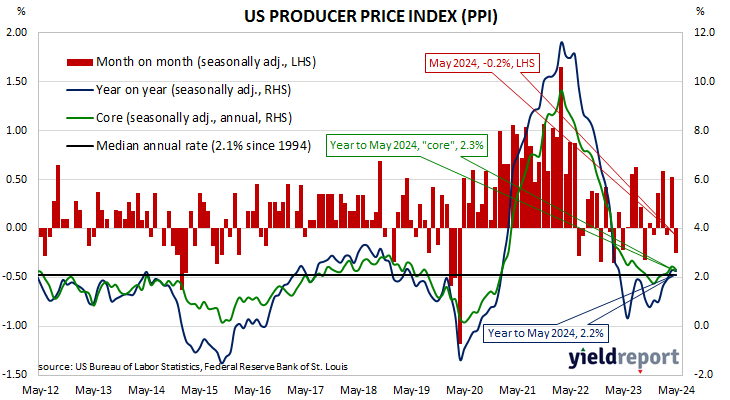Summary: US producer price index (PPI) down 0.2% in May, contrasts with expected increase; annual rate slows to 2.2%; “core” PPI flat over month, up 2.3% over year; Westpac: adds weight to notion US consumer inflation on way to 2.0%; US Treasury yields fall noticeably; rate-cut expectations firm; ANZ: rough estimate for May core PCE is 0.1%; services prices flat, goods prices down 0.8%.
Around the end of 2018, the annual inflation rate of the US producer price index (PPI) began a downtrend which continued through 2019. Months in which producer prices increased suggested the trend may have been coming to an end, only for it to continue, culminating in a plunge in April 2020. Figures returned to “normal” towards the end of that year but then moved well above the long-term average in 2021 and 2022 before falling back over 2023.
The latest figures published by the Bureau of Labor Statistics indicate producer prices declined by 0.2% in May after seasonal adjustments. The result contrasted with the 0.1% increase which had been generally expected as well as April’s +0.5%. On a 12-month basis, the rate of producer price inflation after seasonal adjustments slowed from April’s upwardly-revised figure of 2.3% to 2.2%.
Producer prices excluding foods and energy, or “core” PPI, were unchanged after seasonal adjustments. The result was less than the 0.3% increase which had been generally expected and April’s 0.5% rise. The annual growth rate slowed from 2.4% to 2.3%.
“While not a strong lead for CPI or PCE inflation overall, coming a day after the better-than-expected May
CPI print, this result adds weight to the notion that US consumer inflation is on its way back to 2.0%,” said Westpac senior economist Pat Bustamante.
US Treasury bond yields fell noticeably along the curve on the day. By the close of business, the 2-year Treasury yield had lost 5bps to 4.70% while 10-year and 30-year yields both finished 8bps lower at 4.24% and 4.40% respectively.
In terms of US Fed policy, expectations of a lower federal funds rate in the next 12 months firmed, with at least four 25bp cuts currently factored in. At the close of business, contracts implied the effective federal funds rate would average 5.30% in August, 3bps less than the current spot rate, 5.235% in September and 5.065% in November. June 2025 contracts implied 4.315%, 102bps less than the current rate.
“Both the PPI and CPI inflation measures have elements that are used to calculate monthly PCE inflation,” said ANZ economist Jack Chambers. “Our back-of-the-envelope calculations estimate May core PCE rose in the region of 0.1%, or possibly a touch lower. 0.1% m/m would leave the annual measure of May core PCE inflation at 2.56%, down from 2.75% in April.”
The BLS stated the fall of the index was attributable to a 0.8% decrease in goods prices. The final demand services index remained unchanged.
The producer price index is a measure of prices received by producers for domestically produced goods, services and construction. It is put together in a fashion similar to the consumer price index (CPI) except it measures prices received from the producer’s perspective rather than from the perspective of a retailer or a consumer. It is another one of the various measures of inflation tracked by the US Fed, along with core personal consumption expenditure (PCE) price data.



